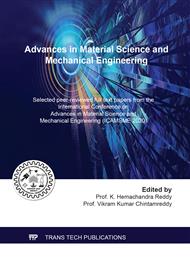[1]
Palanikumar K, Karunamoorthy L., karthikeyan R., and Latha B.Optimization of ma- chining parameters in turning GFRP composites using a carbide (k10) tool based on the Taguchi method with fuzzy logics, Metals and Materials International, 2006; 12 (6), 483-491.
DOI: 10.1007/bf03027748
Google Scholar
[2]
Latha B, and Senthilkumar V S. Fuzzy rule based modelling of drilling parameters for de- limitation in drilling GFRP composites, Journal of Reinforced plastics and composites, 2009;.
DOI: 10.1177/0731684407087570
Google Scholar
[3]
Wong S.V. and Hamouda A.M.S. A fuzzy logic based expert system for mach inability data-on-demand on the internet, Journals of Materials Processing Technology, vol. 2005; (124), 57-66.
DOI: 10.1016/s0924-0136(02)00091-2
Google Scholar
[4]
Suleyman Y. Faruk U. and Haci S.Comparisons of experimental results obtained by de- sign dynamometer to fuzzy model for predicting cutting forces in turning, Material and de- sign, vol. 2006; (27)1139-1147.
DOI: 10.1016/j.matdes.2005.03.010
Google Scholar
[5]
Ozel T. Karpat Y.Predictive modeling of surface roughness and tool wear inhard turning usingregression and neural networks, International Journal of Ma – chinetools and Manufacture2005; (45)467-479.
DOI: 10.1016/j.ijmachtools.2004.09.007
Google Scholar
[6]
Sivarao, Peter Brevern, N.S.M. EI- Tayeb, V.C. Venkatesh V. C. GUI based Mamdani fuzzy in-ference system modeling to predict surface roughness in Laser machining, Int. Journal of Electrical and Computer sciences 2008; (9) 281- 288.
Google Scholar
[7]
Suresh P. V. S. Venkateswara Rao P., and Deshmukh S. G. A genetic algorithmicapproachfor optimization of surface roughness prediction model, International Journal of Machine tools and and Manufactures, 2002; (42) ,675-680.
DOI: 10.1016/s0890-6955(02)00005-6
Google Scholar
[8]
Abhang, L. B. and Hameedullah. M., Empirical modeling of turning parameters using grey relational analysis, Applied Mechanics and Materials, 2011, Vol. 110-116, pp.2596-2603.
DOI: 10.4028/www.scientific.net/amm.110-116.2596
Google Scholar
[9]
Mohd Iqbal, Muhammad Tadjuddin, Laxman B Abhang, Investigation of hole delamination in drillingkeblar composite panel using HSS drill tool, Defect and Diffusion Forum, 2020, Vol. 402, 108-114.
DOI: 10.4028/www.scientific.net/ddf.402.108
Google Scholar
[10]
Laxman B Abhang, Mohd Iqbal, M Hameedullah, Optimization of machining process parameters using moora method, Defect and Diffusion Forum, 2020, Volume 402, 81-89.
DOI: 10.4028/www.scientific.net/ddf.402.81
Google Scholar
[11]
Abhang L.B. and M Hameedullah M. Chip-tool interface temperature prediction model for turning process, International Journal of Engineering Science and Technology, 2010; 2 (4), 382-393.
Google Scholar
[12]
Abhang L B and Hameedullah M. Power prediction model for Turning En-31 steel Using Response surface methodology, Journal of Engineering Science and Technology Review, 2010; 3 (1), 116-122.
DOI: 10.25103/jestr.031.20
Google Scholar
[13]
Abhang L. B. and Hameedullah M. Determination of optimum parameters for multi-performan characteristics in turning by using grey relational analysis, International Journal of Advanced Manufacturing Technology, 2012,.
DOI: 10.1007/s00170-011-3857-6
Google Scholar


